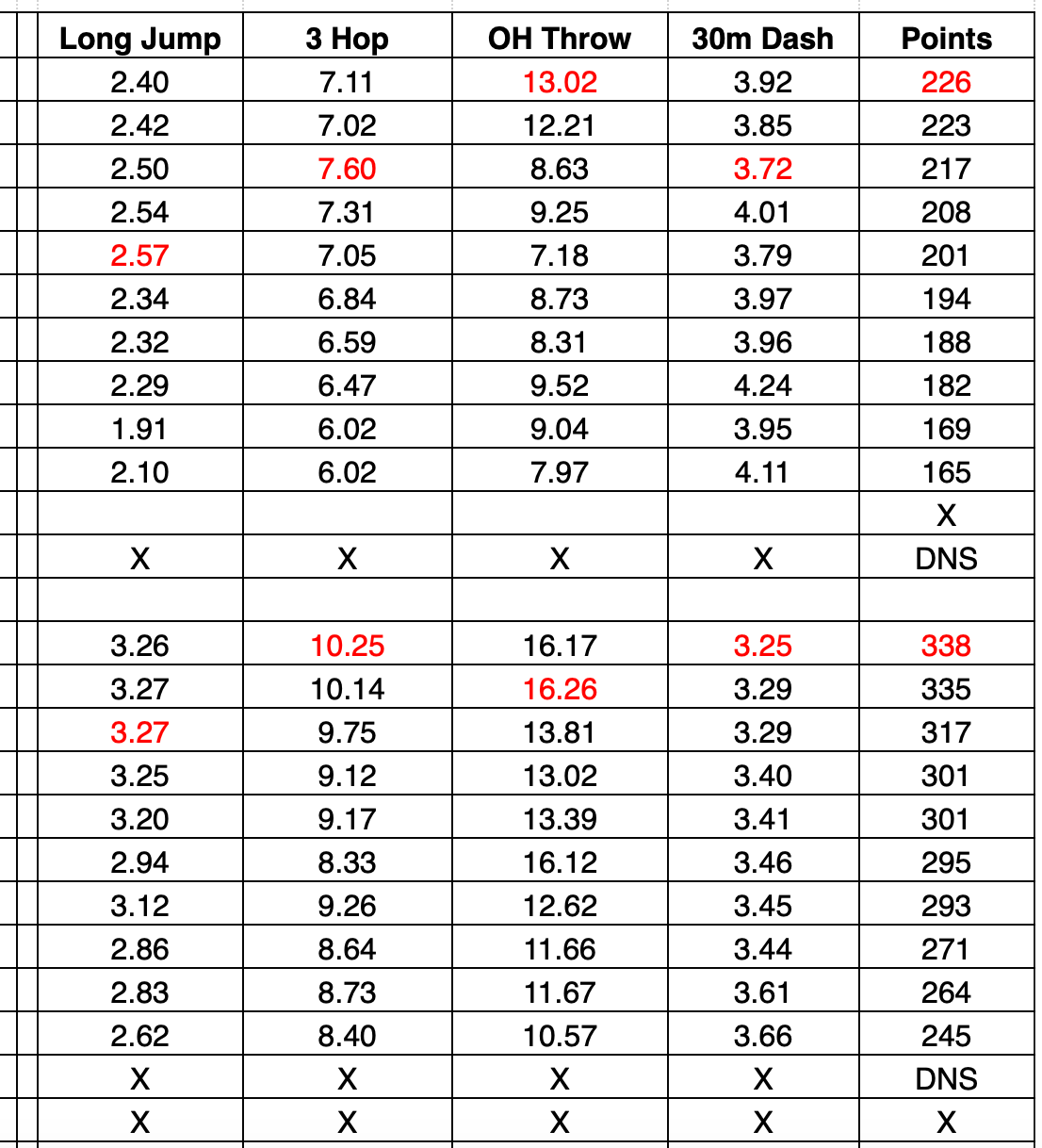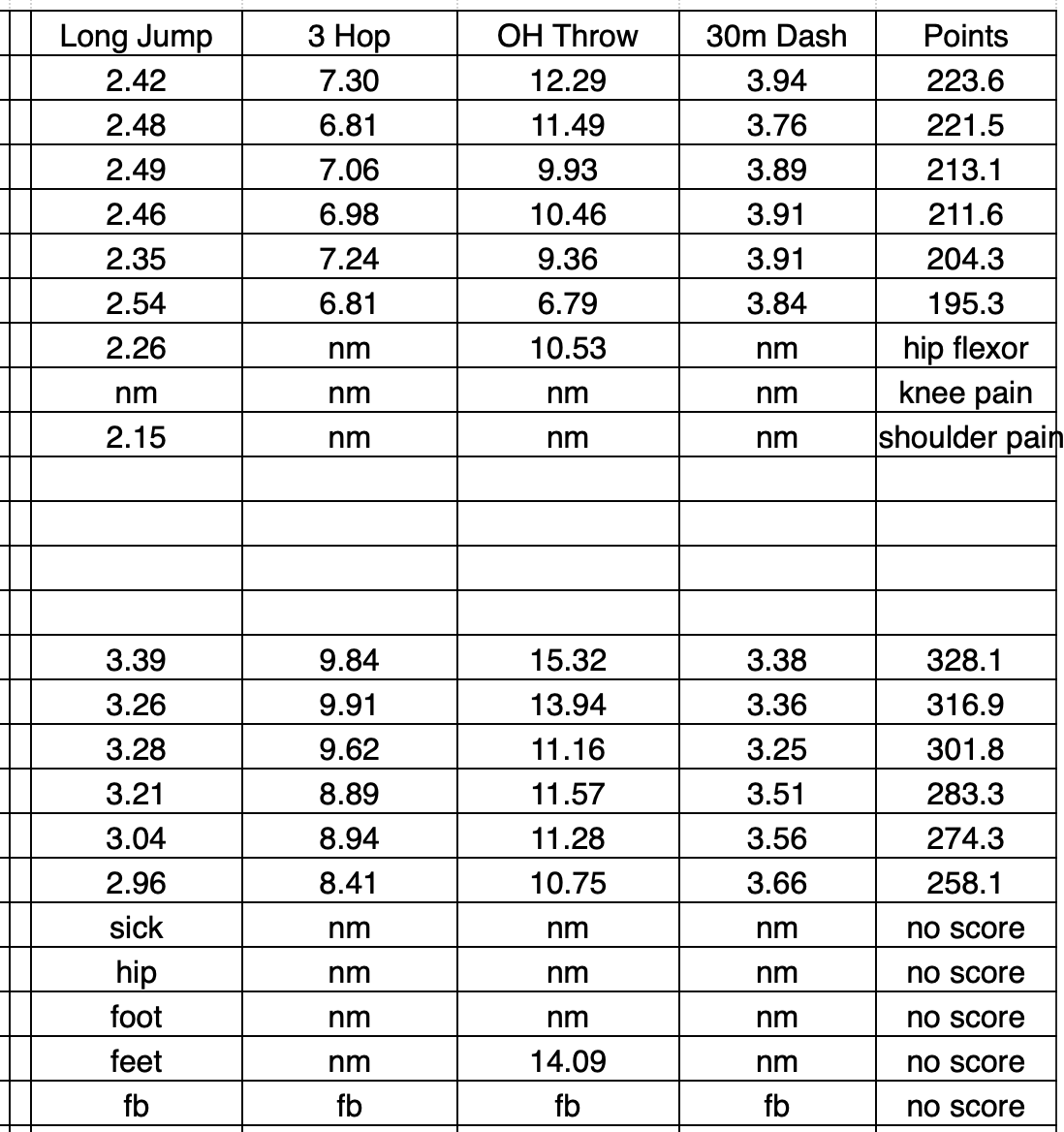PREDICITIONS VS. POTENTIAL
In our world of track and field, testing and data is being utilized more and more to predict an athlete’s times/performances for the season. I’m talking about things like:
Power Clean and Squat numbers
10m flies
30m flies
30m dash
hurdle splits at discounted spacing
hitting marks on Vince Anderson’s acceleration ladder pattern
technology that gives accurate splits/times at practice like the Dartfish, FreeLap, and Brower Timing System
This post is a cautionary tale about telling athletes if they run “X 10m fly time” then they are guaranteed to run 10.30. It’s not as simple as that. Plus, an athlete’s confidence can go down the gutter when those “guarantees” don’t come true. We’ve all seen coaches post stats from their team testing on 10m fly, 30m fly, etc., that supposedly predict or equate to performances on the track. To be straightforward, all of the tests are simply too small to “prove” anything. Certainly data helps us know if someone might be good, bad, average, or great, but it’s not the end all be all.
Other sports have a similar mindset to testing. The NFL combine tests all types of skills, speed, and agility. But we all know that the true test is being on the field and playing the game. The same goes with track & field testing. Yes, we can test their skills, speed, and technique, but the biggest test all athletes face is stepping on the track (or field) and using their mental and physical training to create a big performance.
One of the hot topics and trends currently is the 10m fly. In my opinion, it's just too short to guarantee much in terms of track speed when outdoor’s season shortest race is 100m. Tests like the 30m dash (timed from first contact) can play for OR against body types. Tests like this do not allow an athlete's training or strengths to show up. Long-legged athletes might not be the fastest accelerators and might not be the best at a 30m dash. But their 30m fly might be #1 on the team. And their 150m might be off the charts. And oddly, a 30m dash from the first contact totally ignores reaction time to the gun. The test neutralizes the strength (or weakness) of reacting to the gun in a sprint race. Some will say reaction time is not that important. In my experience…it’s very important.
Many tests certainly show some sparks of potential, but the testing doesn't guarantee anything in either direction. The data doesn't guarantee that an athlete will perform certain marks on meet day, AND doesn't guarantee the athlete CAN’T perform certain marks.
I'm not really interested in giving my athletes predictors from tests because if they don’t accomplish the results, it becomes frustrating and defeating. And the flip of that, is if they hit the performance right way...then what? It kinda puts limits on what the athlete believes they can do from a mental standpoint. I want them to keep progressing at all times with no limits.
PSST…ELITE HURDLE CAMP registration is LIVE!☀️*
*and there’s a discount!
The biggest hurdle camp in the country is this summer! June 20-21, 2024. Coach Clark has helped athletes for 10+ years progress and commit to BIG Ten, SEC schools, and more. Registration is live and there’s a discount for ALL subscribers!
For more information (and the discount) click here.
To register hit the button below⬇️
Jud Logan Taught Me Many Things, Including the British Quad Test
My take is simple, determine what testing is important to you, and then track the performances block to block, season to season, or year to year. With that data you can see if your training is creating PROGRESS for the athlete. I test specific things year to year to see if my annual training plan is truly progressing the athletes I coach. However, I don't use any of the test results as predictors of what an athlete will perform in their upcoming events. Instead, I use it as proof that the athlete is progressing.
Good friend and mentor, Jud Logan, put me onto a set of tests I do believe in. The Quadrathlon Power Test. Jud called it the British Quad Test. It’s a compilation of 4 tests to evaluate overall power output. My findings show that it was created in 1982 to track the progress of the Great British National Throws Squad. The exercises consist of the Standing Long Jump, 3 Broad Jump (continuous Bunny hop), Overhead Shot Throw, and 30m Sprint. Each event gets 3 attempts and the best attempt receives a score. A scoring calculator can be found at https://www.brianmac.co.uk/quad.htm. I like to end the testing with 30m Flys that have a 30m acceleration zone. The 30m fly is an additional test I add that does not get scored, but it’s and important test to me. I log each athlete’s marks year to year. If an athlete's power output is improving, and their 30m fly is improving, we know their best ever is on the way.
Testing from two different seasons, two options of how to format if you're interested
I want my testing to show progress overall, not try and calculate a specific performance/mark. Single testing leaves out too many variables and can create barriers of what the athlete believes they can and can’t do. No thanks! This sport is mentally challenging enough!
With championship meets coming up and helping my family I hope to continue to post every two weeks! If I’m a few days late, bear with me! Thank you for being a subscriber and thank you for reading!
What type of testing do you do?








